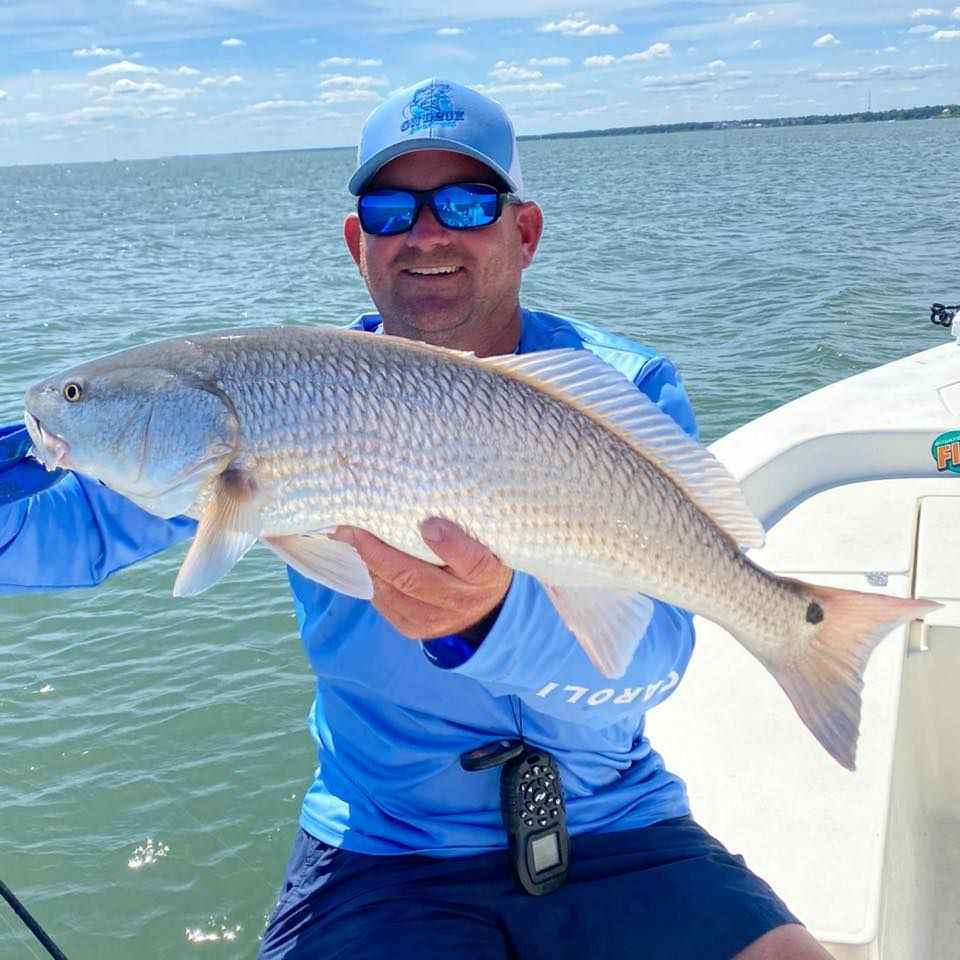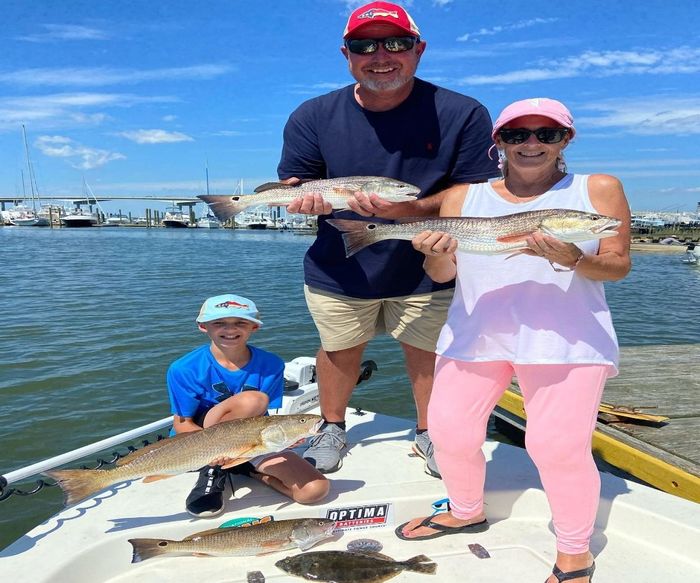Chasing the Dream
Daniel Griffee fish from New Bern, NC, to Cape Lookout, NC. He primarily targets red drum, speckled trout, and flounder.

A Little Something About Our Author/Captain
In 2005, I graduated from Appalachian State, then moved to the Coast of NC. The inland system looked like bass heaven with cypress trees, lily pads, and sawgrass-lined banks. The largemouth were not very big in this area, though.
I've been fishing in farm ponds and mountain streams since I was three years old. I grew up fishing Lake Hickory chasing largemouth bass, crappie, and catfish. One thing I loved about fishing is the fact I can use something that’s not real, and get the wild animal to eat it. I love the pull, the fight, and the feeling of success.
I actually wanted to become a bass pro angler, until one day, I caught my first red drum and that changed everything.

I was having a tough day one time and was throwing a chartreuse tandem Colorado/willow leaf spinnerbait in brackish water. I then saw a fish swimming down the bank towards me. I thought it was a bowfin and wanted a bite. I tossed the spinnerbait past the fish reeling it right down beside its right side. As soon as the spinnerbait got towards the fish’s head, it turned and smashed the spinnerbait! The fight was on and I actually had to use drag for the first time ever. Got the fish in the boat and it was a tagged red drum. From that moment on, I never cared about a largemouth bass and have been chasing and learning about the red drum.
Conquering the Tides
I was always afraid of being stuck when the tides would start dropping out. I never really pushed the limits, until one day, I decided to test myself. I wanted to see if I would actually get stuck. I knew fish were in the area but couldn’t find them on the high tide.
I took a break and ate a hearty sandwich. I moved around while trying to put the pieces of the puzzle together. It was then that I heard a “pop”. I turned and saw a shrimp jumping a seagull, flying above it trying to eat it while a red drum under the water was also trying to eat the shrimp. I tossed my topwater out and the water boiled with an explosion as the fish inhaled my lure. When I stood up to fight the fish, I saw around 75 to 100 red drum swimming around my boat. I was amazed! These fish came out of the grass and sat in the shallows waiting for the tide to come back in.
The next morning, we ended up winning third place - out of 60 boats - catching fish after fish within a three-hour period.
Since then, I learned to not hate the falling low tide, but to embrace it and love what it could offer.
Fish Species I Target and My Favorite Fishing Spots

In the Eastern part of NC, there are three river systems. Newport River, Neuse River, and North River. The North River and Newport River are tidal-driven and flow towards the Neuse River which is wind-driven from the Pamlico Sound. I fish from New Bern NC to Cape Lookout, NC, and everywhere in between.

I primarily target red drum, speckled trout, and flounder. I also target sheepshead, Spanish mackerel, cobia, black drum, and king mackerel.
My preferred method of fishing is casting topwater (walk the dog) style lures like the Zara spook or bomber badonka donk. I always have them tied on jigs with soft plastics, and a Bomber Popping Cork, with either cut bait, live shrimp, or gulp underneath. When the tides are low, we go deep water fishing around docks and bridges with cut bait and live shad. I am not a fan of trolling. It bores me to death, but I can ride the ocean and cast all day to fish-busting bait on the surface.
Typically, my trips are backwater inshore fishing trips. I focus on Inland Tidal Marshlands, River Systems, Backwater Low Country. It's all dependent on the wind strength and direction, and tide.
When people think of fishing even if they are in 3-5 feet of water, they don’t understand how far a fish can go with that much water. If water is over a fish's gills, it can swim, live, eat, etc. As the tide falls, the water filters out into the main pond, channel, bay, etc., making any fish way up in the grass come out. The tide can range from 1-4 feet based on the winds and moon phase. Being in an area where you’re floating in 10 inches of water and seeing all the activity swimming just under the surface is pretty incredible. What is more incredible is seeing the targeted species swimming and feeding in those same areas and conditions. Watching a red drum measuring 24-30’’ in length swimming in 6-10’’ of water is pretty incredible.
Top Tips and My Best Techniques

People think you have to be out in deep water, but that’s not always the case. Putting the trolling motor down and easing along a bank looking for the fish, fishtails, boils, or wakes from the fish turns into more of a hunt. You go to the area they should be in and look for those fish. If you were to sit at one spot for hours or start blind casting, you’re going to waste time, effort. These fish swim up and down the bank eating on the prey that has flushed out of the marshes.
At high tide, they may be spread out on all the points such as oyster rocks, laydown trees, and others. But when the tide falls out, they can go from being in a 500-yard area to a 10-yard area. So you must be willing to stalk and hunt. Once you see them, see their movements, see their actions - blow up the bait without a care in the world and your blood will be pumping. Then the skill set comes into play. Making a cast too far can get you stuck or broken off. Making a cast behind the fish that is moving is no good, they don’t turn around to see what you have to offer, and they keep moving forward looking for food. Sometimes, putting the cast on top of them spooks them and they vanish. I’ve watched them move and sit still making you think they have left when they were right beside you the entire time. Making a cast just in front of the feeding fish, seeing that fish eat your lure, and then fighting the monster in inches of water you thought you’d be stuck in makes for the best fight and memories.
My favorite bait is a Chartreuse Zara Spook. An Orange Bomber Popping Cork 2’ of leader with a 3/0 circle hook and a white gulp shrimp is a close second. And of course, I always have my favorite equipment with me - a Minn Kota Terrova Trolling Motor and Power Pole!
What It’s Like to Fish with Me
I’ve run over 200 trips in the last two years. Ninety-five of the people that have gone on a trip with me have nothing but positive feedback. Not only it is about catching fish, but also about the entire experience, the stories, the sites, the memories made. I had so many good experiences because they are all unique. Unfortunately, there was a very small number of people who may not have enjoyed the casting style of fishing, or have tried to specifically target certain species even after being told it's not the best thing to do and failed.
The most memorable experiences I had were when parents would see their children catch a fish, and to their amazement, it’s bigger than any fish they’ve caught or even imagined catching. Another favorite experience of mine is when I would get older fishermen - who have already fished all over - catch the species have been chasing.
I never promise a successful catch, nor the size or the kind of species. I promise to put you in the best possible place, and the best possible scenario to get you the opportunity at a fish. I’ve had days where it was easy and had a good catch, only to find absolutely no signs of life - on the exact same spot - the following day.
Fish have tails, which means they move, they also don’t get big by being dumb.
Lastly, I am a huge catch-and-release fisherman. There’s no reason to take always the biggest fish but remember to take what’s going to eat better instead. I try to keep the waters clean and free of trash and litter. I also believe in using circle hooks under corks or for Carolina rigs so you can release more rather than gut hook and kill more.




